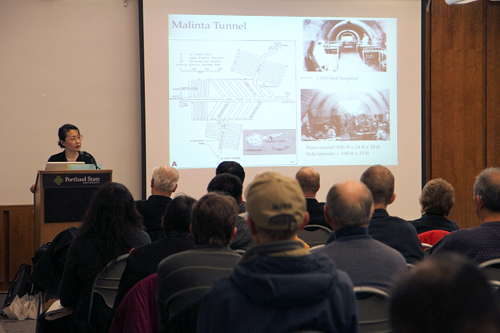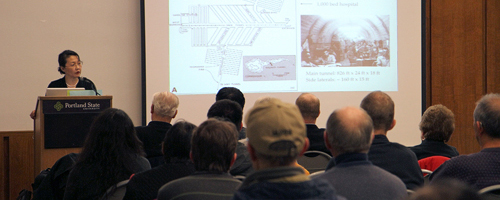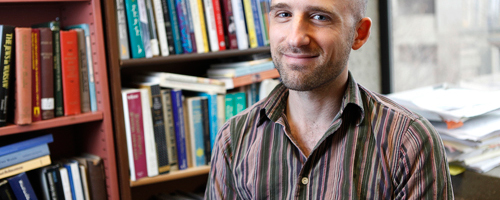In the aftermath of World War II, two American army sergeants—both prisoners of war—faced harrowingly different futures. One, a Japanese-American intelligence agent, was deemed a war hero. The other, an Anglo-American, was charged with treason. And yet the similarities between Richard Sakakida and John Provoo were startling.
Testimony and treason: a tale of two sergeants

In the aftermath of World War II, two American army sergeants—both prisoners of war—faced harrowingly different futures. One, a Japanese-American intelligence agent, was deemed a war hero. The other, an Anglo-American, was charged with treason.
And yet the similarities between Richard Sakakida and John Provoo were startling.
Speaking at Portland State on Thursday, Brown University history professor Dr. Naoko Shibusawa wove a narrative of two men whose diverging fates upended racialized expectations of the Cold War era. Shubisawa pieced together their story by sifting through 5,000 pages of trial testimony.
“Both were stationed at Corregidor…a tadpole-shaped fortress island in the Philippines,” Shibusawa said. Both spoke Japanese and were interpreters between American prisoners and Japanese capturers.
Their stories diverged after the war when Provoo, accused of wartime collaboration with the Japanese that led to the death of a U.S. soldier, was arrested.
After eight months of investigation, there was no evidence to prove Provoo’s affiliation with the Japanese, so he reenlisted.
In 1949, Provoo was honorably discharged from the U.S. Army. Only an hour after his release, however, the FBI arrested him and charged him with treason.
Sakakida was also charged with treason, but this charge came from the Japanese, who claimed his Japanese ancestry made him a traitor.
After being held captive and tortured by the Japanese, Sakakida escaped and returned to the Army. A couple of years later, he rose to the rank of lieutenant colonel. He was also posthumously awarded a congressional citation.
“Sakakida exemplified that blood sacrifice and heroism were needed to gain acceptance by the nation,” Shibusawa said.
Shibusawa said the case highlighted the postwar emphasis on tolerance.
“Racial liberalism dovetailed with America’s goal to be the champion of the free world,” said Shibusawa, who painted a contrast between wartime racial suspicion and the quick postwar shift to valuing the Japanese as a Cold War ally.
“Cold War liberalism is the opposite side of the coin to Cold War Oriental paranoia,” she added.
Provoo’s arrest made the front page of The New York Times.
“The U.S press was one of the biggest stakeholders in the trial,” Shibusawa said. “Provoo’s trial gained so much attention that jury members had to be reminded to ignore newspaper, TV and radio coverage of the case.”
One of the key witnesses against Provoo was his fellow sergeant, Sakakida. In October 1952, Sakakida took the stand at the federal courthouse in New York City.
Sakakida was described by The New York Times as “an inscrutable figure behind glittering glasses.”
“[Sakakida] riveted the courtroom with his tales of Provoo’s wartime treachery,” Shibusawa said. The only Japanese-American prisoner of war at Corregidor, Sakakida was correctly suspected of being a member of the U.S. Army intelligence.
Provoo, who was gay, was depicted much differently, Shibusawa said.
“Newspapers depicted him as a paragon of American manliness queered in the process, donning khakis with geisha robes,” she said.
Sakakida’s testimony initially seemed conclusive.
“He testified that Provoo was the only American who was allowed free movement, who was never slapped or made to do hard labor,” Shibusawa said.
But cross-examination chipped away at Sakakida’s credibility. “It was established that Sakakida, too, was exempt from slapping,” Shibusawa said. “He, too, had relative freedom of movement.”
Much of the case against Provoo came from a Japanese Imperial Army sergeant whose testimony regarding Provoo shifted from early letters of praise to an implicating narrative.
“The former enemy now seemed a reliable source of information,” Shibusawa said.
Born in Hawaii to Japanese immigrants, Sakakida was recruited by U.S Army intelligence for his unusually adept Japanese language skills.
Sakakida testified that Provoo, too, spoke relatively good Japanese—but Provoo’s knowledge of the language came largely from a six-month course, Shibusawa explained.
Throughout the cross-examination, Provoo had a calm, even demeanor. But he was found guilty of treason by the jury and sentenced to life in prison.
“If the appellate judge was right, Provoo’s homosexuality influenced the guilty verdict,” Shibusawa said.
But in the end, Provoo won his appeal.
“Although ultimately found innocent, Provoo felt hounded by the treason allegation for the rest of his life,” Shibusawa said.
Provoo eventually became an ordained Buddhist monk. He moved to Hawaii, where he participated in anti-Vietnam War demonstrations.
Shibusawa’s presentation was cosponsored by PSU’s Center for Japanese Studies, the Oregon Nikkei Endowment, the PSU history department and the Portland Center for Public Humanities.
Shibusawa, who is the author of America’s Geisha Ally: Reimagining the Japanese Enemy, underscored difficulties in constructing historical narratives.
“As we sift through testimony, we encounter the problem of arbitrarily privileging some details over others,” Shibusawa said.
“The question isn’t what history is, but how history works,” she said. “Whose versions [of history] gain veracity, and why?”






